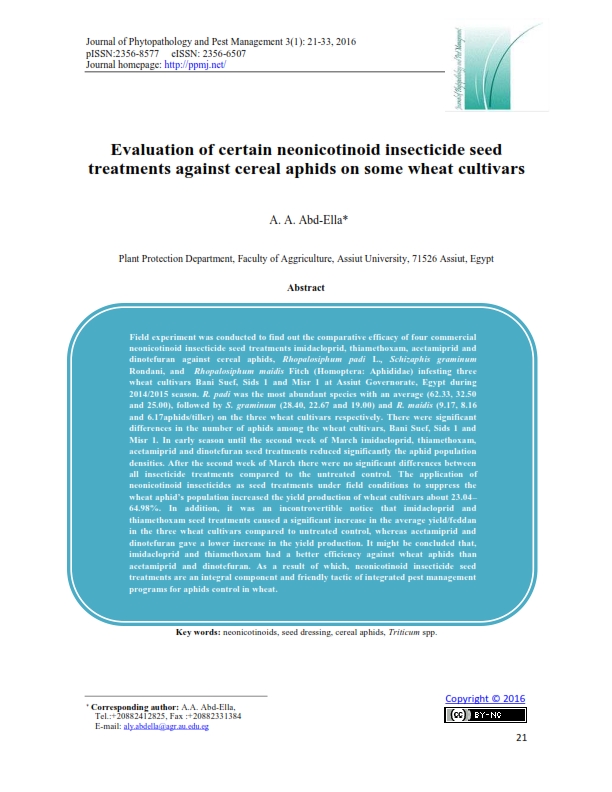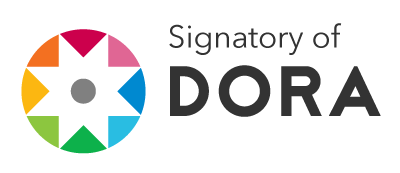Evaluation of certain neonicotinoid insecticide seed treatments against cereal aphids on some wheat cultivars
Keywords:
neonicotinoids, seed dressing, cereal aphids, Triticum spp.Abstract
Field experiment was conducted to find out the comparative efficacy of four commercial neonicotinoid insecticide seed treatments imidacloprid, thiamethoxam, acetamiprid and dinotefuran against cereal aphids, Rhopalosiphum padi L., Schizaphis graminum Rondani, and  Rhopalosiphum maidis Fitch (Homoptera: Aphididae) infesting three wheat cultivars Bani Suef, Sids 1 and Misr 1 at Assiut Governorate, Egypt during 2014/2015 season. R. padi was the most abundant species with an average (62.33, 32.50 and 25.00), followed by S. graminum (28.40, 22.67 and 19.00) and R. maidis (9.17, 8.16 and 6.17aphids/tiller) on the three wheat cultivars respectively. There were significant differences in the number of aphids among the wheat cultivars, Bani Suef, Sids 1 and Misr 1. In early season until the second week of March imidacloprid, thiamethoxam, acetamiprid and dinotefuran seed treatments reduced significantly the aphid population densities. After the second week of March there were no significant differences between all insecticide treatments compared to the untreated control. The application of neonicotinoid insecticides as seed treatments under field conditions to suppress the wheat aphid’s population increased the yield production of wheat cultivars about 23.04–64.98%. In addition, it was an incontrovertible notice that imidacloprid and thiamethoxam seed treatments caused a significant increase in the average yield/feddan in the three wheat cultivars compared to untreated control, whereas acetamiprid and dinotefuran gave a lower increase in the yield production. It might be concluded that, imidacloprid and thiamethoxam had a better efficienÂcy against wheat aphids than acetamiprid and dinotefuran. As a result of which, neonicotinoid insecticide seed treatments are an integral component and friendly tactic of integrated pest management programs for aphids control in wheat.
Â
Metrics

Published
How to Cite
Issue
Section
License
Authors who publish with Journal of Phytopathology and Disease Management agree to the following terms:
- Authors retain copyright and grant the journal right of first publication with the work simultaneously licensed under a Creative Commons Attribution License that allows others to share the work with an acknowledgement of the work's authorship and initial publication in this journal.
- Authors retain copyright and grant the journal right of first publication with the work simultaneously licensed under the Creative Commons Attribution-Non Commercial License (CC BY-NC). This allows others to share the work with an acknowledgement of the work's authorship and initial publication in this journal.
- Archives of Agricultural Sciences Journal is an Open Access Journal, and articles published are distributed under the terms of the Creative Commons Attribution-Non Commercial License (CC BY-NC). Readers may copy, distribute, and display the work for non commercial purposes with the proper citation of the original work. However, the journal retains the right to exploit subsidiary rights on behalf of the authors.
- Authors are able to enter into separate, additional contractural arrangements for the non-exclusive distribution of the journal's published version of the work (e.g. post it to an institutional repository or publish it in a book), with an acknowledgement of its initial publication in this journal.
- Authors are permitted and encouraged to post their work online (e.g., in institutional repositories or on their website) prior to and during the submission process with full disclosure to the journal, as it can lead to productive exchanges, as well as earlier and greater citation of published work. Following publication in Archives of Agricultural Sciences Journal, the author should update the repository, and include a citation and link to the published work.
Click here for more information on Licensing policy
.png)




